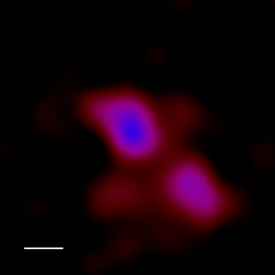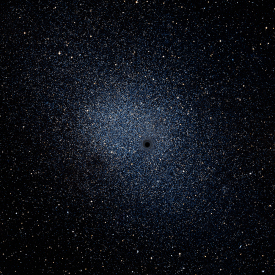XMM-Newton spots monster black hole hidden in tiny galaxy
19 December 2014
First impressions can be deceptive – astronomers have used ESA's X-ray satellite XMM-Newton to find a massive black hole hungrily feeding within a tiny dwarf galaxy, despite there being no hint of this black hole from optical observations.
 |
| X-ray emission from dwarf galaxy J1329+3234. Credit: ESA/XMM-Newton/N. Secrest, et al. (2015) |
The galaxy, an irregular dwarf named J1329+3234, is one of the smallest galaxies yet to contain evidence of a massive black hole. Located over 200 million light-years away, the galaxy is similar in size to the Small Magellanic Cloud, one of our nearest neighbouring galaxies, and contains a few hundred million stars.
In 2013, an international team of astronomers was intrigued to discover infrared signatures of an accreting black hole within J1329+3234 when they studied it with the Wide-Field Infrared Survey Explorer (WISE).
The same team has now investigated the galaxy further, using ESA's XMM-Newton to hunt for this black hole in X-rays – and found something very surprising.
"The X-ray emission from J1329+3234 is over 100 times stronger than expected for this galaxy," says Nathan Secrest of George Mason University in Virginia, USA, lead author of the new study published in The Astrophysical Journal. "We would typically expect to find low-level X-ray emission from stellar-mass black holes within the galaxy, but what we found instead was emission consistent with a very massive black hole."
The combined X-ray and infrared properties of this galaxy can only be explained by the presence of a massive black hole residing in J1329+3234, similar to the supermassive black holes found at the centres of much more massive galaxies.
While the exact mass of the black hole is not known, it must be at least 3000 times as massive as the Sun, although it is likely to be much more massive than that. If the black hole in J1329+3234 is similar to known low-mass supermassive black holes, then it has a mass of around 150 000 times that of the Sun.
A feeding black hole at the centre of a galaxy is known as an active galactic nucleus, or AGN. In the region surrounding the black hole, material from the galaxy emits intensely bright radiation as it swirls inwards towards the centre of the galaxy and is devoured by the black hole. AGNs powered by massive black holes are commonplace in large galaxies, but they appear to be rarer in galaxies without a central "bulge" of stars – dwarf galaxies being a key example.
 |
| Artist's impression of accreting black hole in a dwarf galaxy. Credit: ESA/ATG medialab |
"This is a really important discovery," says co-author Shobita Satyapal, also from George Mason University. "It's interesting enough that such a tiny galaxy has such a large black hole, but this also raises questions about how these black holes form in the first place."
Astronomers believe that the "seeds" of massive black holes formed very early on in the Universe, along with the first generation of stars. These seed black holes then grew into massive black holes via a string of galaxy mergers. As the galaxies merged, so did their central black holes.
The turbulent merging process would feed the accreting black holes with copious amounts of material while simultaneously building up large, bulge-dominated galaxies. However, with each successive merger information about the properties of the original black hole is lost, meaning that astronomers cannot determine the mass of the original seeds by looking at massive bulge-dominated galaxies – instead they probe their dwarf and bulgeless relatives, such as J1329+3234, for clues.
Finding a massive black hole within such a tiny bulgeless galaxy provides support for the theory that black holes may have grown very efficiently within the gaseous haloes of forming galaxies, originating in massive, collapsing clouds of primordial gas.
Along with J1329+3234, Secrest and his colleagues found several hundred other bulgeless galaxies from the WISE survey that also show intriguing infrared properties – many of which, like J1329+3234, display no evidence for AGNs in optical light.
"The idea that we could find an accreting black hole even in a galaxy with no optical evidence for one is exciting," notes Secrest. "Massive black holes and AGNs may be much more common within low mass and bulgeless galaxies than we currently think."
In recent years, growing numbers of massive black holes have been identified within dwarf and bulgeless galaxies. However, it is much harder to find them than it is to find their supermassive counterparts – they are less likely to show up in optical studies since they are often obscured by dust and are usually much dimmer, making them difficult to detect above surrounding light.
This emphasises the importance of multi-wavelength sky surveys, says ESA's XMM-Newton project scientist Norbert Schartel. "Using a mix of optical, infrared, and X-ray observations was vital here," he adds. "The sensitivity of XMM-Newton made it possible not only to discover this black hole but to also fully characterise its spectrum, meaning we can say with much more certainty that it's a black-hole-fuelled AGN."
More information
"An optically obscured AGN in a low mass, irregular dwarf galaxy: A multi-wavelength analysis of J1329+3234" by N. Secrest, S. Satyapal, M. Gliozzi, B. Rothberg, S. Ellison, W. Mowry, J. Rosenberg, J. Fischer, and H. Schmitt, is published in The Astrophysical Journal.
The European Space Agency's X-ray Multi-Mirror Mission, XMM-Newton, was launched in December 1999. The largest scientific satellite to have been built in Europe, it is also one of the most sensitive X-ray observatories ever flown. More than 170 wafer-thin, cylindrical mirrors direct incoming radiation into three high-throughput X-ray telescopes. XMM-Newton's orbit takes it almost a third of the way to the Moon, allowing for long, uninterrupted views of celestial objects.
Contacts
Nathan Secrest
George Mason University
Fairfax, Virginia, USA
Email: nsecrest![]() masonlive.gmu.edu
masonlive.gmu.edu
Phone: +1-301-760-0210
Shobita Satyapal
George Mason University
Fairfax, Virginia, USA
Email: ssatyapa![]() gmu.edu
gmu.edu
Phone: +1-703-993-1283
Norbert Schartel
ESA XMM-Newton Project Scientist
Directorate of Science and Robotic Exploration
European Space Agency
Email: Norbert.Schartel![]() esa.int
esa.int
Phone: +34-91-8131-184


